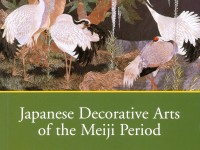Japanese Decorative Arts of the Meiji Period
A catalogue of the Ashmolean’s Japanese decorative arts from the Meiji period (1868-1912), by Oliver Impey and Joyce Seaman (published Oxford, 2005).

Publications online: 54 objects
Fan-shaped panel with a waterfall
-
Literature notes
Fan-shaped panel in soft metal of two main colours, shibuichi and shakudō, engraved in katakiri with a waterfall. Engraved signature: Unno Shōmin koku. Seal: Hoshu sei. Dated: Meiji kanato-unatsu no hi (summer 1891).
Half a generation younger than Kanō Natsuo, and his natural successor Unno Shōmin (1844-1915) is usually considered the finest Meiji metalworker after Natsuo [see EAX.3852]. He won prizes in many International and National Expositions, and one of his figure studies in the Third National Exposition was purchased by the Imperial Household Agency. He was a professor at the Tōkyō Art School from 1890 and became an Imperial Artist in 1896.
The deep cutting of the engraved panel is a triumph of skill in a difficult process; with a broad chisel this nevertheless achieves a surety of line that is quite remarkable. The juxtaposition of the dark shakudō riverbank with the silver waterfall is typical of Shōmin’s inventiveness. This is also remarkable for being dated. It would originally have been mounted on a framed panel of kiri wood (Paulownia), probably without glass. -
Details
- Associated place
- Date
- Summer 1891
- Artist/maker
-
Unno Shōmin (1844 - 1915) (metalworker)
- Material and technique
- shibuichi and shakudō, with katakiri engraving (oblique chisel-cuts); gold seal
- Dimensions
- 19.5 x 40.4 x 0.1 cm max. (height x width x depth)
- Material index
-
processed material › metal › alloy › copper alloy › shibuichi,processed material › metal › alloy › silver alloy › shibuichi,processed material › metal › alloy › copper alloy › shakudō,
- Object type index
- No. of items
- 1
- Credit line
- Purchased with the assistance of the Story Fund, 1998.
- Accession no.
- EA1998.220
-
Further reading
Impey, Oliver, and Joyce Seaman, Japanese Decorative Arts of the Meiji Period 1868-1912, Ashmolean Handbooks (Oxford: Ashmolean Museum, 2005), no. 28 on p. 60, pp. 8 & 68, illus. pp. 60-61
Glossary (2)
shakudō, shibuichi
-
shakudō
alloy of copper and gold, patinated to a dark blue-black colour
-
shibuichi
alloy of copper and silver, patinated to a dull grey-green colour
Location
-
- currently in research collection
Objects are sometimes moved to a different location. Our object location data is usually updated on a monthly basis. Contact the Jameel Study Centre if you are planning to visit the museum to see a particular object on display, or would like to arrange an appointment to see an object in our reserve collections.
Publications online
-

Japanese Decorative Arts of the Meiji Period
Fan-shaped panel in soft metal of two main colours, shibuichi and shakudō, engraved in katakiri with a waterfall. Engraved signature: Unno Shōmin koku. Seal: Hoshu sei. Dated: Meiji kanato-unatsu no hi (summer 1891).
Half a generation younger than Kanō Natsuo, and his natural successor Unno Shōmin (1844-1915) is usually considered the finest Meiji metalworker after Natsuo [see EAX.3852]. He won prizes in many International and National Expositions, and one of his figure studies in the Third National Exposition was purchased by the Imperial Household Agency. He was a professor at the Tōkyō Art School from 1890 and became an Imperial Artist in 1896.
The deep cutting of the engraved panel is a triumph of skill in a difficult process; with a broad chisel this nevertheless achieves a surety of line that is quite remarkable. The juxtaposition of the dark shakudō riverbank with the silver waterfall is typical of Shōmin’s inventiveness. This is also remarkable for being dated. It would originally have been mounted on a framed panel of kiri wood (Paulownia), probably without glass.
Notice
Object information may not accurately reflect the actual contents of the original publication, since our online objects contain current information held in our collections database. Click on 'buy this publication' to purchase printed versions of our online publications, where available, or contact the Jameel Study Centre to arrange access to books on our collections that are now out of print.
© 2013 University of Oxford - Ashmolean Museum

